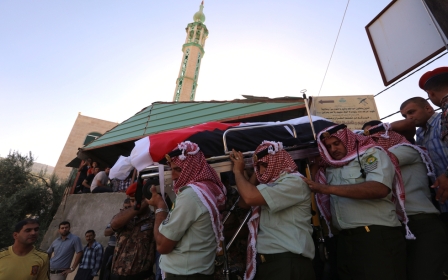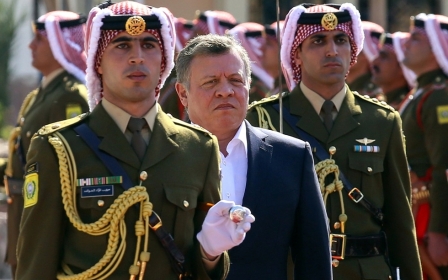ANALYSIS: Jordan, the island of stability crumbling at its edges

Jordan has long been an island of stability in a region on fire, proudly reminding the world of its ongoing welcome for refugees when other countries had hit their limit.
But in the wake of two recent attacks, the latest of which saw seven soldiers killed and 23 injured on a remote stretch of the border just after dawn on Tuesday, and under the weight of an economic crisis, Jordan has sealed its borders with Syria and Iraq to civilian traffic.
At Ruqban, the 60,000-person-strong border camp two kilometres from last week’s blast, Jordanian troops have raised a barbed-wire fence to keep people out, and frozen all refugee admissions. Aid agencies can no longer access Ruqban to provide food and medical aid, and life-saving water deliveries have been stop-start since the blast.
There are reports that people in the settlement have begun dying in the high summer heat, but even a week after the attack, Jordan’s eastern border remains a crime scene.
The Ruqban attack, claimed by pro-IS media on Sunday night as “the work of an Islamic State fighter,” seemed to confirm the worst nightmare of Jordanian authorities, who have long warned of a growing security threat among Syrians at their border.
The location of the attack underscores the disaster. Beyond housing 60,000 displaced Syrians and a massive humanitarian operation, Ruqban and the military installations housed there are of quietly vital security importance. Tuesday’s blast targeted a fast-growing military site where US, UK and Jordanian special forces provide frontline support to a shadowy Syrian opposition group based just across the border.
Remote Ruqban is one of the US-led coalition's last reliable launching points for operations against IS in southern and south-eastern Syria. Experts believe the group is on the rise in this desert, having slipped south out of Deiz al-Zour and Palmyra, hundreds of kilometres to the north.
“IS is so expert in using the desert to hide their movements. Historically, when IS is weakened, like in 2008 in Iraq, they disappeared inside the desert,” Islamist movement researcher Marwan Shahada told Middle East Eye.
The video released with the statement seems to underscore this message. It shows a vehicle racing across the open desert towards the border, kicking up a cloud of dust, but evidently, raising no alarms. Moments later, the explosion.
Chaotic border
Ruqban, consisting of a military outpost and a border crossing-point named for that outpost, is a bleak, wind-battered stretch of sand where a demilitarised zone two kilometres deep runs between Jordan and Syria, bordered on each side by a chest-high earthen berm.
The refugee camp sprawls across the demilitarised zone, and is overlooked from the Jordan side by barricades, border observation towers, pre-fabricated caravans where humanitarians work, and the Ruqban Company HQ.
Two kilometres south of the camp, Ruqban Company HQ serves as a forward base for Jordanian, British and American special forces supporting the New Syrian Army, a Pentagon-trained Syrian rebel group operating in southeast Syria. It is a launching point for drones, HIMARS rocket systems and, according to Syrian rebels, covert operations into Syria.
The HQ is also a checkpoint for myriad aid workers and contractors making daily journeys to the Jordanian berm, where they distribute food, water and medical aid to those beyond. According to UN data, two-thirds of people requesting aid are women and children.
The ad-hoc camp is home to a separate Free Syrian Army (FSA) faction Lions of the East, which claims to handle camp security – due to the camp’s location in a demilitarised zone, Jordanian soldiers and aid workers have no access inside – and battle IS militants alongside the New Syrian Forces.
In addition to assorted military personnel, refugees and aid workers, there are tradespeople, merchants, and daily fleets of more than 40 water trucks. Photos and video of Ruqban show a crowded, chaotic place.
Slipped through traffic
A security report seen by MEE says the attacking vehicle on Tuesday slipped in with a stream of traffic coming from the refugee camp. The attacker used its main gate to enter Jordan, then took advantage of a weakness in the barricade system to make his way to the military facility, and detonated near the HQ's clinic and barracks.
The report notes that Jordanian observation towers may not have accurately identified the attacker due to “other elements operating on the vicinity of the camp”.
A humanitarian worker with knowledge of the area told MEE that one truck could easily go unnoticed in the flow of traffic coming from beyond the berm.
“There are a lot of vehicles driving from the berm to the base, so a vehicle going that way would have been one of many,” he said.
According to Younes al-Salamah, a spokesman for Lions of the East, the attack’s origins were not in the camp, but somewhere north-west of it, in the Syrian desert.
“The car came from a part of the desert where there are no FSA factions,” he told MEE.
Researcher Shahada said the video pointed to “a gap in security and military control” at Ruqban – a gap that overrode high-tech cameras, heat sensors and top surveillance technology.
Shahada believes there is evidence to suggest IS is not the only militant group active in this southern stretch of desert. He also believes, more worryingly, that IS was not in fact the group behind the attack, and that this group’s identity is being deliberately obscured.
“This is very bad for Jordan because it means there may be multiple groups in the desert, trying to enter the border from that area.”
Growing security threat
While an investigation is ongoing, it underscores the security threat Jordanian authorities have long highlighted in their refusal to immediately admit all Syrians bottlenecked at Ruqban.
Attacks on the country’s prized security services are becoming more frequent, although Tuesday's attack was the worst loss of life for the Jordanian military since the beginning of the Syrian conflict.
Jordan’s borders are among the best-protected in the world, with a $100m border protection system completed in 2016 by US defence contractor Raytheon. The army that patrols these frontiers is designed for defence, said Jordan analyst Sean Yom and assistant professor of political science at Temple University.
“The Jordanian army is not an offensive strike army. It was designed to defend the kingdom against external attack first and foremost, and delay any potential invasions until Western help could arrive,” he told MEE.
But defending Ruqban HQ and policing a 60,000-strong knot of people from just one side are complex, interconnected missions – missions insiders say the military could see spinning out of control. One aid worker at Ruqban told MEE that in recent weeks, senior Jordanian military figures have complained to the UN that more surveillance is needed, and demanded CCTV and a drone of their own “to monitor this damned berm”.
The demand highlights the separation of operations at Ruqban. While Jordanian border guards monitor the settlement and the increasingly crowded roads, the men operating out of the Ruqban military base have a different mission – supporting the New Syrian Army in operations against IS at al-Tanf, an area on the Syria-Iraq border which has been fought over since February.
The US proxies are one of the sole surviving forces from the catastrophic $500m US-led programme to train and equip Syrian rebels to fight IS. But just over the Ruqban border, they are being put to use.
'Unprecedented' US support
Military operations at Ruqban have been quietly gathering speed since February, when the first US and UK-trained members of the proxy force was deployed to Syria from Jordan. They were positioned at al-Tanf, a strategic position close to the Iraqi border, scarcely 15km from Ruqban HQ. Two months later, the NSA was joined by the Lions of the East.
Salamah, the Lions' spokesman, said the group sent a first shift of 50 men from their base near Qalamoun, north of Damascus, to Ruqban in April.
They patrol the settlement in trucks and on motorcycles that Salamah says were provided through the Military Operations Centre (MOC), a weapons pipeline from Amman run by western and Arab military staff who are part of the coalition.
Salamah said most of his group’s efforts were directed at remedying the “very miserable” humanitarian situation at Ruqban by building schools, basic medical facilities and more mosques – additions that draw more people to Ruqban, further entrenching both the humanitarian and security crises – but they also back up New Syrian Army in its battles against IS.
These battles have been increasingly bloody, and in May, the US government began handing out military-grade medical kits, stocked with vacuum seals and coagulants, to the FSA posted at the berm.
“This is a strategic way to buy loyalty from proxy fighters. It’s quite a new move,” said a senior aid worker. “There are an increasing number of military activities going on up there on the border, and there is a group clearly being supplied by the US.”
But on 16 June, the New Syrian Army's al-Tanf operation was hit hard by Russian warplanes. Three separate air raids, allegedly using cluster bombs, killed two including one member of the Lions of the East, and further complicated the region's dynamics.
Four days later, the suicide bomber crossed at Ruqban at dawn, killing the six Jordanian officers. The humanitarian operation was put on ice immediately, but Salamah and other FSA fighters in the area say the military operation is ongoing.
Analyst Yom said he was not surprised at the shift in priorities at Ruqban.
“With the elections coming up in a few months, a new technocratic government in play, and more reform promises, the palace can't afford to have a continued string of terrorist attacks whether they originate internally or externally as it attempts to convince the public that things are progressing,” he said.
This article is available in French on Middle East Eye French edition.
New MEE newsletter: Jerusalem Dispatch
Sign up to get the latest insights and analysis on Israel-Palestine, alongside Turkey Unpacked and other MEE newsletters
Middle East Eye delivers independent and unrivalled coverage and analysis of the Middle East, North Africa and beyond. To learn more about republishing this content and the associated fees, please fill out this form. More about MEE can be found here.




